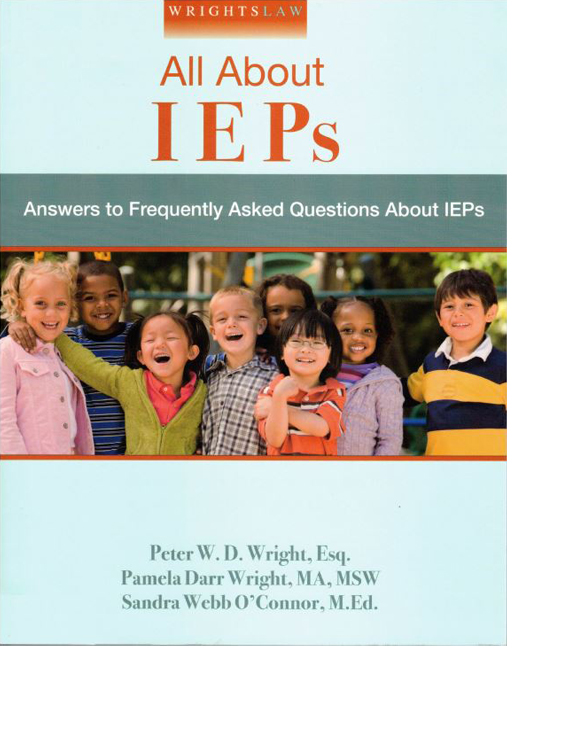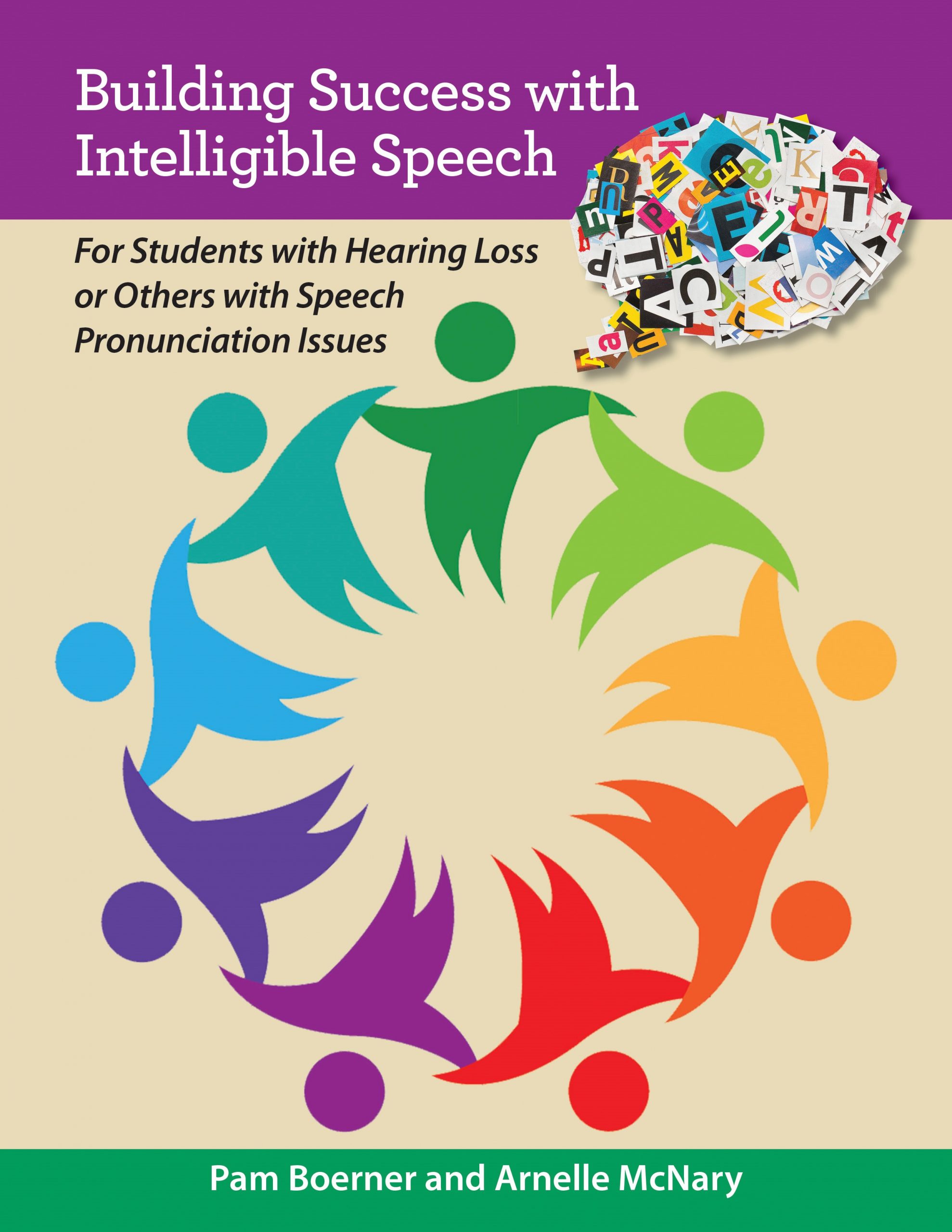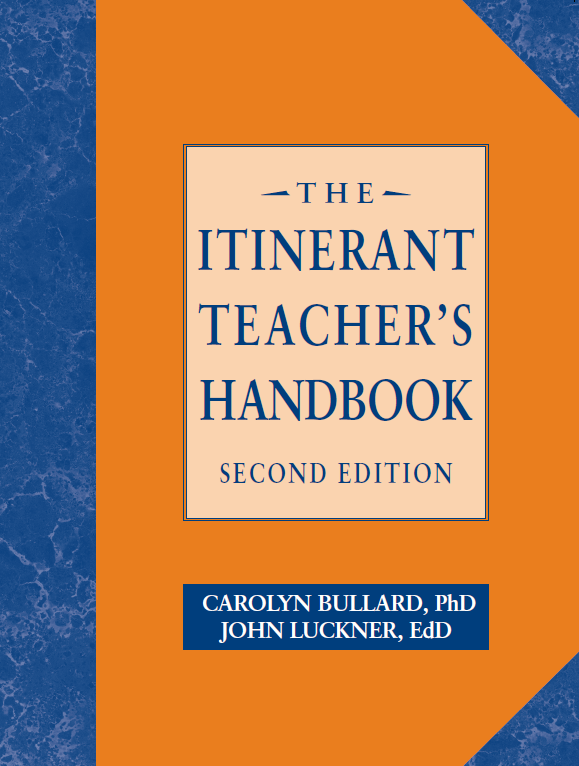Related Products
For Professionals
- Amplification
- Assessment of Student Skills, Challenges, Needs
- Early Childhood: Infants, Toddlers, Preschool
- Hearing Loss – Identification, Impact and Next Steps
- IDEA Law Summary Information
- Language and Speech Development Issues
- Legal Issues in Serving Children with Hearing Loss
- Listening (Auditory Skills) Development
- Planning to Meet Student Needs
- Self-Advocacy Skills for Students with Hearing Loss
- Self-Concept: How the Child with Hearing Loss Sees Himself
- Social Skills
- Speech Perception & Learning
Related Teacher Tools Takeout Items
Determining Appropriate Service Delivery to Improve Outcomes
 Regardless of the move to full inclusion and the shortage of teachers of the deaf/hard of hearing, school teams remain obligated to the student to identify areas of educational need, appropriate IEP goals, amount of service time needed, by whom, and in what setting.
Regardless of the move to full inclusion and the shortage of teachers of the deaf/hard of hearing, school teams remain obligated to the student to identify areas of educational need, appropriate IEP goals, amount of service time needed, by whom, and in what setting.
In the March 22, 2017 US Supreme Court decision, Chief Justice Roberts wrote, “…IDEA demands more. It requires an educational program reasonably calculated to enable a child to make progress appropriate in light of the child’s circumstances.” If a child is not fully included, school officials must look at the child’s unique needs and required level of specialized instruction before developing an IEP that is “pursuing academic and functional advancement.” If a child is 6 months behind expected achievement levels, an itinerant DHH teacher cannot maintain a year’s growth and also make up the level of delay with only twice per week 30-minute sessions of service. Providing an inappropriate amount of educational support will not result in the needed level of student outcomes nor will it make teachers of the DHH appear effectual.
“Kids in the middle” refers to students who may not be served in delivery models that consist of direct services from a teacher of the deaf and hard of 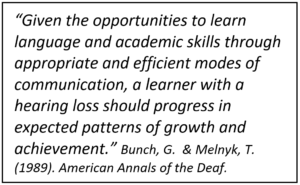 hearing. Therefore, the resulting services may, or may not, adequately address the communication, social, and academic needs of these students. Central to the concept of special education is the idea that the Individual Education Planning Team will collaboratively determine the special and general education services a student needs, based on the goals and objectives developed for him or her. This process is meant to ensure that each student will receive services tailored specifically to his or her unique set of needs. With the recent clarification by the US Supreme Court it is anticipated that school teams will once again consider the amount and intensiveness of services necessary to allow students with hearing loss to progress at a rate typical of hearing peers. Our goals should focus on helping students become effective communicators, competent readers, and knowledgeable consumers of goods and services.
hearing. Therefore, the resulting services may, or may not, adequately address the communication, social, and academic needs of these students. Central to the concept of special education is the idea that the Individual Education Planning Team will collaboratively determine the special and general education services a student needs, based on the goals and objectives developed for him or her. This process is meant to ensure that each student will receive services tailored specifically to his or her unique set of needs. With the recent clarification by the US Supreme Court it is anticipated that school teams will once again consider the amount and intensiveness of services necessary to allow students with hearing loss to progress at a rate typical of hearing peers. Our goals should focus on helping students become effective communicators, competent readers, and knowledgeable consumers of goods and services.
One result of the Supporting Success survey last April to identify the roles and responsibilities of itinerant teachers of the deaf/hard of hearing indicated that 25% of respondents used matrices to guide their discussions in the determination of the level of service delivery. With increased pressure to ‘serve less, more remotely’ under the assumption that the student will learn as  well when teacher of the DHH services are minimized, many teachers and districts are exploring or implementing the use of service delivery matrices.
well when teacher of the DHH services are minimized, many teachers and districts are exploring or implementing the use of service delivery matrices.
It is important to preface this discussion recognizing that a service delivery matrix can only be a guide to decision making, assisting in team discussions and not the final word in appropriate levels of service. The focus needs to remain on “what the student needs to catch up and keep pace.”
Hearing loss results in learning needs that are unique, including some areas of need that cannot be effectively addressed in a mainstream classroom (refer to Early October Bimonthly Update). For the teacher(s) of the DHH who would like to begin the conversation of using a service delivery matrix, the following handouts may be a helpful addition to discussions with administration:
- Why Involve the Teacher of the Deaf/Hard of Hearing on the Assessment Team and the IEP?
- Role Comparisons: Supporting Students Who are Deaf or Hard of Hearing
- Considerations for Assessment & Service Provision for Children with Hearing Loss
Below are examples of matrices that are already in use. Some are DHH 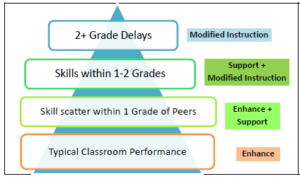 specific while others are not. Some take into account the social, technology, accommodations, and self-advocacy needs of students and others do not.
specific while others are not. Some take into account the social, technology, accommodations, and self-advocacy needs of students and others do not.
Use of a service delivery matrix may provide the evidence basis needed for justification of appropriate levels of service to meet student needs – academic, class participation and expanded core skill development.
Example Matrices for Determination of Level of Service Delivery
- Educational Impact for Students who are Deaf or Hard of Hearing The Michigan Department of Education – Low Incidence Outreach has produced an exceptionally helpful tool that has recently been made computer fillable. It is suggested that persons interested monitor their website for the new fully accessible version to be released.
- Hearing Itinerant Services Rubric Many varying factors are considered
 within the 3-page matrix. Individual child issues or circumstances need to be carefully considered as well as the rubric recommendations. Thanks much to SEDOL in Illinois for sharing this 2014 resource.
within the 3-page matrix. Individual child issues or circumstances need to be carefully considered as well as the rubric recommendations. Thanks much to SEDOL in Illinois for sharing this 2014 resource. - Service Delivery Guide for Educating Students Who are Deaf and Low Functioning was developed by Region 4, Houston Texas in 2016. As the title indicates, this matrix is different from the others as it is specific to students who are Deaf-plus.
- Matrix of Services was developed by the Florida Department of Education Bureau of Exceptional Education and Student Services in 2017 as guidance to indicate the intensity of support required to meet the needs of students identified as exceptional. It is not DHH specific. Be sure to download the large Matrix of Services Handbook that provides detailed explanations of all domains for appropriate use. Note: this large file may take extra time to access.
2018 © Karen L. Anderson, PhD, Late November Update, Supporting Success for Children with Hearing Loss http://successforkidswithhearingloss.com This information is not intended as legal advice.

